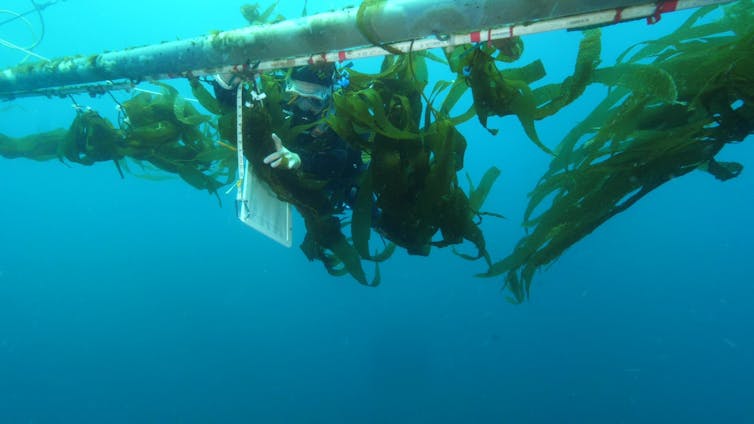Move over, corn and soybeans: The next biofuel source could be giant sea kelp
- Written by Diane Kim, Adjunct Assistant Professor of Environmental Studies and Senior Scientist, USC Wrigley Institute, USC Dornsife College of Letters, Arts and Sciences
The Research Brief[1] is a short take about interesting academic work.
The big idea
Giant kelp, the world’s largest species of marine algae[2], is an attractive source for making biofuels. In a recent study, we tested a novel strategy for growing kelp[3] that could make it possible to produce it continuously on a large scale. The key idea is moving kelp stocks daily up to near-surface waters for sunlight and down to darker waters for nutrients.
Unlike today’s energy crops, such as corn and soybeans, growing kelp doesn’t require land, fresh water or fertilizer. And giant kelp can grow over a foot per day under ideal conditions.
Kelp typically grows in shallow zones near the coast, and thrives only where sunlight and nutrients are both plentiful. There’s the challenge: The ocean’s sunlit layer extends down about 665 feet (200 meters) or less below the surface[4], but this zone often dosen’t contain enough nutrients to support kelp growth.
Much of the open ocean surface is nutrient-poor year-round. In coastal areas, upwelling[5] – deep water rising to the surface, bringing nutrients – is seasonal. Deeper waters, on the other hand, are rich in nutrients but lack sunlight.
Our study demonstrated that kelp withstood daily changes in water pressure as we cycled it between depths of 30 feet (9 meters) and 262 feet (80 meters). Our cultivated kelp acquired enough nutrients from the deeper, dark environment to generate four times more growth than kelp that we transplanted to a native coastal kelp habitat.
“Farming” kelp in the ocean could produce abundant material for making sustainable biofuel.Why it matters
Making biofuels from terrestrial crops such as corn and soybeans competes with other uses for farmland and fresh water. Using plants from the ocean[6] can be more sustainable, efficient and scalable.
Marine biomass can be converted into different forms of energy, including ethanol, to replace the corn-derived additive that currently is blended into gasoline in the U.S.[7] Perhaps the most appealing end-product is bio-crude – oil derived from organic materials[8]. Bio-crude is produced through a process called hydrothermal liquefaction, which uses temperature and pressure[9] to convert materials like algae into oils.
These oils can be processed in existing refineries into bio-based fuels for trucks and planes. It’s not practical yet to run these long-distance transportation modes on electricity because they would require enormous batteries[10].
By our calculations, producing enough kelp to power the entire U.S. transportation sector would require using just a small fraction of the U.S. Exclusive Economic Zone[11] – the ocean area out to 200 nautical miles from the coastline.
How we do our work
Our work is a collaboration between the USC Wrigley Institute[12] and Marine BioEnergy Inc.[13], funded by the U.S. Department of Energy’s ARPA-E MARINER (Macroalgae Research Inspiring Novel Energy Resources)[14] program. The research team includes biologists, oceanographers and engineers, working with scuba divers, vessel operators, research technicians and students.
We tested kelp’s biological response to depth cycling by attaching it to an open ocean structure we call the “kelp elevator,” designed by the team’s engineers. The elevator is anchored near the USC Wrigley Marine Science Center on California’s Catalina Island. A solar-powered winch raises and lowers it daily to cycle the kelp between deep and shallow water.
We depth-cycled 35 juvenile kelp plants for three months and planted a second set at a nearby healthy kelp bed for comparison. To our knowledge, this was the first attempt to study the biological effects of physical depth cycling on kelp. Prior studies focused on artificially pumping deep nutrient-rich water to the surface[15].
 A diver at the ‘kelp elevator.’
Maurice Roper, CC BY-ND[16]
A diver at the ‘kelp elevator.’
Maurice Roper, CC BY-ND[16]
What’s next
Our results suggest that depth cycling is a biologically viable cultivation strategy. Now we want to analyze factors that can increase yields, including timing, water depth and kelp genetics.
Many unknowns need further study, including processes for permitting and regulating kelp farms, and the possibility that raising kelp on a large scale could have unintended ecological consequences. But we believe marine biomass energy has great potential to help meet 21st-century sustainability challenges.
[Over 100,000 readers rely on The Conversation’s newsletter to understand the world. Sign up today[17].]
References
- ^ Research Brief (theconversation.com)
- ^ largest species of marine algae (www.nps.gov)
- ^ novel strategy for growing kelp (doi.org)
- ^ about 665 feet (200 meters) or less below the surface (oceanservice.noaa.gov)
- ^ upwelling (oceanservice.noaa.gov)
- ^ plants from the ocean (www.energy.gov)
- ^ blended into gasoline in the U.S. (www.eia.gov)
- ^ oil derived from organic materials (greenchemicalsblog.com)
- ^ uses temperature and pressure (www.youtube.com)
- ^ require enormous batteries (theconversation.com)
- ^ the U.S. Exclusive Economic Zone (www.gc.noaa.gov)
- ^ USC Wrigley Institute (dornsife.usc.edu)
- ^ Marine BioEnergy Inc. (www.marinebiomass.com)
- ^ MARINER (Macroalgae Research Inspiring Novel Energy Resources) (arpa-e.energy.gov)
- ^ pumping deep nutrient-rich water to the surface (arpa-e.energy.gov)
- ^ CC BY-ND (creativecommons.org)
- ^ Sign up today (theconversation.com)
Authors: Diane Kim, Adjunct Assistant Professor of Environmental Studies and Senior Scientist, USC Wrigley Institute, USC Dornsife College of Letters, Arts and Sciences

